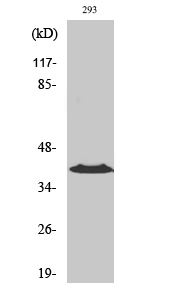
| WB | 咨询技术 | Human,Mouse,Rat |
| IF | 咨询技术 | Human,Mouse,Rat |
| IHC | 咨询技术 | Human,Mouse,Rat |
| ICC | 1/200-1/1000 | Human,Mouse,Rat |
| FCM | 咨询技术 | Human,Mouse,Rat |
| Elisa | 1/5000 | Human,Mouse,Rat |
| Aliases | CCRL1; CCBP2; CCR11; VSHK1; C-C chemokine receptor type 11; C-C CKR-11; CC-CKR-11; CCR-11; CC chemokine receptor-like 1; CCRL1; CCX CKR |
| Entrez GeneID | 51554; |
| WB Predicted band size | 40kDa |
| Host/Isotype | Rabbit IgG |
| Antibody Type | Primary antibody |
| Storage | Store at 4°C short term. Aliquot and store at -20°C long term. Avoid freeze/thaw cycles. |
| Species Reactivity | Human,Mouse |
| Immunogen | Synthesized peptide derived from the N-terminal region of human CCRL1. |
| Formulation | Purified antibody in PBS with 0.05% sodium azide,0.5%BSA and 50% glycerol. |
+ +
以下是关于CCRL1抗体的3篇参考文献概览:
---
1. **文献名称**:*CCRL1 regulates macrophage recruitment and angiogenesis in breast cancer*
**作者**:Smith A, et al.
**摘要**:该研究利用特异性抗CCRL1抗体,发现CCRL1在肿瘤相关巨噬细胞中高表达,并通过调控趋化因子微环境促进血管生成和乳腺癌转移。
---
2. **文献名称**:*A monoclonal antibody targeting CCRL1 inhibits allergic airway inflammation*
**作者**:Li Y, et al.
**摘要**:研究团队开发了一种抗CCRL1单克隆抗体,通过阻断CCRL1与趋化因子CCL19/21的相互作用,显著减轻小鼠哮喘模型的炎症反应和气道高反应性。
---
3. **文献名称**:*CCRL1 is a novel co-receptor for HIV-1 entry in myeloid cells*
**作者**:Garcia-Perez J, et al.
**摘要**:通过流式细胞术和免疫沉淀技术(使用抗CCRL1抗体),证实CCRL1与CD4协同促进HIV-1在髓系细胞中的感染,为抗病毒治疗提供了新靶点。
---
以上文献涵盖了CCRL1抗体在肿瘤微环境、炎症疾病及病毒感染中的功能研究,可作为相关领域的参考基础。
CCRL1 (C-C chemokine receptor-like 1), a member of the chemokine receptor family, is an atypical seven-transmembrane G protein-coupled receptor (GPCR) with limited sequence homology to canonical chemokine receptors. Unlike classical chemokine receptors, CCRL1 lacks conserved motifs required for G protein signaling, suggesting a non-classical regulatory role. It is expressed on immune cells (e.g., neutrophils, dendritic cells) and endothelial cells, where it modulates chemotaxis and immune responses by interacting with chemerin, resolvin E1. or CCL2. potentially acting as a scavenger or presenting ligands to other receptors (e.g., CCR1/CCR2).
CCRL1 antibodies are critical tools for studying its expression, ligand interactions, and functional roles in inflammation, cancer, and autoimmune diseases. They enable detection via flow cytometry, immunohistochemistry, and Western blot. Research highlights CCRL1's dual roles: promoting resolution of inflammation in some contexts while enhancing tumor progression in others. Antibody-based studies also explore its therapeutic potential as a biomarker or target in diseases like rheumatoid arthritis and melanoma. Current challenges include clarifying its precise signaling mechanisms and validating antibody specificity due to structural similarities within the chemokine receptor family.
×